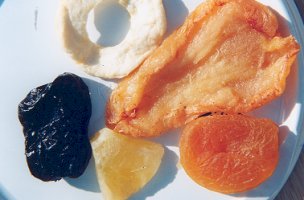Dried fruits include all fruit types preserved by a drying process. Fruit intended for drying is harvested at the climacteric stage, when the juice and sugar content are at their maximum. Preserving by drying works on the principle that, by reducing the water content, the biochemical and microbiological processes which impair the quality of the dried fruit are restricted considerably. The main types of dried fruit transported in relatively large quantities are raisins, dates, figs and apricots (see Fig. 122). With a water content < 30%, dried fruit is an organic product with a low water content and thus belongs to water content class 2 (WCC 2) (see Table 21).
| Type of dried fruit | Water content in % | Rel. humidity in % |
| Apples, dried | 20 - 24 | 70 - 75 |
| Apricots, dried | 22 - 25 | 65 - 70 |
| Pears, dried | 22 | 65 - 75 |
| Dates, dried | 14 - 20 | 50 - 60 |
| Figs, dried | 18 - 30 | 60 - 65 |
| Peaches, dried | 20 - 23 | 70 - 73 |
| Prunes | 18 - < 20 | 60 - 70 |
| Raisins | 14 - 16 | 55 - 65 |
| Sultanas | 17 - 19 | 60 |
Table 21: Water contents and optimum relative humidities for dried fruit [28]
 |
Figure 122: Dried fruit; Photo: U. Scharnow 1 - apple ring 2 - prune 3 - pear 4 - pineapple 5 - apricot |
Dried fruits are strongly hygroscopic. Their sorption isotherms rise steeply. The respiration processes of the dried fruit are suspended by drying; it is therefore a product displaying 3rd order biotic activity (BA 3).
Dried fruit requires particular temperature, humidity/moisture and possibly ventilation conditions (SC VI) (storage climate conditions). Dried fruit does not have any particular requirements as to ventilation conditions, if it is container dry. Dried fruit is transported in standard containers, subject to compliance with upper and lower limits for the water content of goods and packaging. Ventilated containers would be best, in order to achieve better temperature and moisture conditions.
Transport instructions and damage
Most of the changes suffered by dried fruit are associated with its hygroscopicity. The optimum water contents and associated equilibrium moisture contents are indicated in Table 21.
It is clear from this Table that the water contents are much higher than those of cereals and oil-bearing seeds/fruits; however these contents correspond to lower equilibrium moisture contents, which are often exceeded during transport. Given that heat and moisture are the primary causes of undesired changes (mold, fermentation, syrup formation, the coolest possible positions should be selected for containers carrying dried fruit or refrigerated containers should be used. If the relative humidity falls below the values indicated, the dried fruit becomes tough and hard and tends towards candying.
Packaging requirements
When palletizing dried fruit, care must be taken to ensure that the fruit's packaging can withstand the pallet stack pressure. Since the stack heights in a container are limited structurally, this may be achieved with standard packaging. If there are any doubts about stability, intermediate layers of boxboard may be used to improve it. If the fruit itself has to absorb the pressure, it tends to form syrup, especially in the lower layers. The syrup comes out of the fruit and may stick the entire packaging together.
Mold risk
The sorption isotherms for dried fruit (see Fig. 123) show that the equilibrium moisture contents are very low, being way below the optimum living conditions for molds (mold growth threshold at 75% relative humidity. Since relative humidity values of above 75% can occur in a standard container, dried fruit is in danger of developing mold. This may also occur of cartons, cases or bags have absorbed moisture from sweat, rain or seawater in containers which are not watertight. Mold growth is encouraged by high temperatures. Molds may form poisonous metabolic products (mycotoxins).
 |
Figure 123: Sorption isotherms for dried fruit (20°C)
— plums, dried --- sultanas, dried ···· apricots, dried ••• apples, dried. |
Insect infestation/Diseases
Pests which may infest dried fruit include moths (e.g.dried fruit moth, almond moth, meal moth) and mites as well as some beetles (e.g. sap beetle, sawtoothed grain beetle, flour beetle. All soft-skinned dried fruits, in particular figs, sultanas, currants and apricots, are at great risk of mite infestation. Mite infestation is particularly dangerous because the consumption of mite-infested foodstuffs may lead to severe gastrointestinal conditions. Rats, mice or ants can also be a problem.